Step 2: Putting up the wires
Strip both ends of wires
-insert one end of each wire into sockets numbered
-Gnd(black wire in my case)-this will be the common ground connection
– 13 (green wire in my case)
– 12 (yellow wire in my case)
– ~11 (orange wire in my case)
– ~10 (red wire in my case)
– 9 (brown wire in my case)
– 8 (brown wire in my case)
Step 3: Hooking up wires to the breadboard
– hook up the wire connected to gnd(black in my case) to the common vertical line on the the sides of the breadboard
– connect other wires to different horizontal lines at at-least 3 lines left in between(just for convenience)
Confused?-see image
Step 4: Hook up the LED
– Put up the shorter end(-ve) of each led to the common ground line on the vertical line
– put up the longer end(+ve) of each led to the respective coloured wire connected horizontal line
Step 5: Write, compile and run the sketch
open the arduino software
copy and paste the following sketch-
int led1 = 13;
int led2 = 12;
int led3 = 11;
int led4 = 10;
int led5 = 9;
int led6 = 8;
// the setup routine runs once when you press reset:
void setup() {
// initialize the digital pins as outputs.
pinMode(led1, OUTPUT);
pinMode(led2, OUTPUT);
pinMode(led3, OUTPUT);
pinMode(led4, OUTPUT);
pinMode(led5, OUTPUT);
pinMode(led6, OUTPUT);
}Getting the parts
parts needed-
– An arduino board(arduino uno preferable for starters)-don’t worry if u have other and a to b cable
get it here(for Indians)- http://shop.sumeetinstruments.com/index.php?route=product/product&path=69_70&product_id=374
– A breadboard
– 7 pieces of wires(preferably differently coloured and more than 6 inches in length)- jumper/solid core preferable
– 6 leds (any color)
tools needed-
– wire stripper and cutter/or pliers (you don’t need them if you have a pair of strong jaws like me) 🙂
For more detail: Arduino led pendulum


